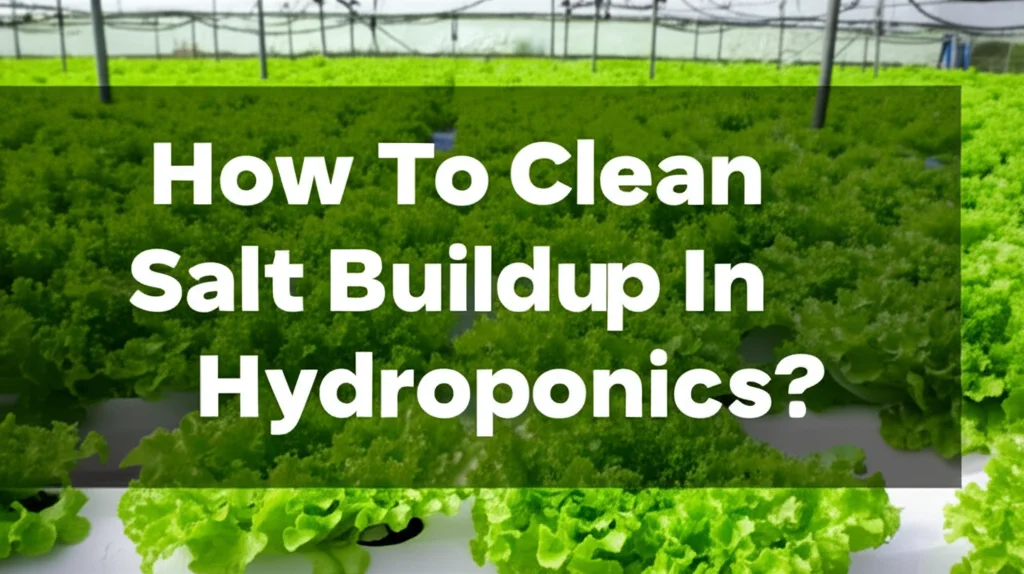· Hydroponics · 7 min read
How To Clean Salt Buildup In Hydroponics?

Keeping Your System Healthy: How To Clean Salt Buildup In Hydroponics?
Have you noticed a white, crusty residue forming in your hydroponic system? This is likely salt buildup, a common issue that can significantly impact your plants’ health. Salt buildup occurs when nutrients, primarily from your fertilizer, accumulate over time. It’s a natural consequence of hydroponics, but ignoring it can lead to nutrient imbalances, reduced oxygen levels, and ultimately, stunted growth or even plant death. This article will guide you through understanding, preventing, and effectively cleaning salt buildup in your hydroponic system, ensuring your plants flourish. We’ll cover everything from identifying the problem to implementing long-term solutions.
Takeaway:
- Regularly monitor your nutrient solution’s PPM/EC.
- Flush your system with pH-balanced water when salt levels rise.
- Use high-quality nutrients and avoid overfeeding.
- Maintain proper system hygiene to prevent buildup.
What is Salt Buildup in Hydroponics?
Simply put, salt buildup in hydroponics refers to the accumulation of mineral salts left behind after water evaporates. These salts are the components of your nutrient solution – nitrogen, phosphorus, potassium, calcium, magnesium, and various micronutrients. As water evaporates, these salts don’t; they remain and accumulate on surfaces like your reservoir, grow media, and roots. This buildup isn’t table salt (sodium chloride) but a mix of beneficial plant nutrients that become detrimental in high concentrations. Managing this buildup is crucial for a successful hydroponic garden.
Understanding the Causes of Salt Buildup
Before diving into cleaning methods, it’s important to understand why salt buildup happens. Several factors contribute to this issue. First, evaporation is a major culprit. The more water that evaporates, the more concentrated the salts become. Second, using hard water with high mineral content can exacerbate the problem. Third, over-fertilizing your plants – providing more nutrients than they can absorb – leads to excess salts in the system. Finally, inadequate ventilation can slow down evaporation, contributing to salt concentration. Identifying the root cause helps you prevent future buildup.
How Often Should You Clean Salt Buildup?
There isn’t a one-size-fits-all answer, but regular monitoring is key. You should check your nutrient solution’s PPM (parts per million) or EC (electrical conductivity) at least once a week. These measurements indicate the concentration of salts in the water. A significant increase suggests buildup is occurring. Generally, a flush is recommended when PPM/EC levels exceed the recommended range for your specific plants. For most plants, a PPM of 500-800 is a good starting point, but always research the ideal range for your crop. Proactive monitoring prevents severe buildup and keeps your system running smoothly.
Flushing Your Hydroponic System: A Step-by-Step Guide
Flushing is the most common and effective way to remove salt buildup. This involves replacing your nutrient solution with pH-balanced water and allowing it to circulate through the system. Here’s how to do it:
- Prepare pH-Balanced Water: Use clean water with a pH between 5.5 and 6.5. This ensures the water doesn’t introduce new imbalances.
- Drain the Reservoir: Completely empty your nutrient reservoir.
- Fill with pH-Balanced Water: Refill the reservoir with the pH-balanced water.
- Circulate the Water: Run your pump for 15-30 minutes to circulate the water through the entire system, reaching all roots and components.
- Drain and Repeat: Drain the water and repeat steps 3 and 4 at least two to three times. You’ll likely notice the water becoming cloudy as it dissolves the salt buildup.
- Refill with Fresh Nutrient Solution: Once the water runs clear, refill the reservoir with a fresh, properly mixed nutrient solution.
Flushing effectively removes accumulated salts, restoring a healthy environment for your plants. You can find more information on maintaining a clean system at https://www.beacleaner.com/how-to-clean-luxury-vinyl-plank-flooring/.
Cleaning Individual Components: Beyond the Reservoir
While flushing addresses the nutrient solution, salt buildup can also accumulate on individual components. Here’s how to tackle those:
- Grow Media: If using inert media like rockwool or coco coir, consider replacing it periodically. These materials can retain salts over time.
- Net Pots & Trays: Remove net pots and trays and scrub them with warm water and a mild detergent. Rinse thoroughly to remove any residue.
- Pumps & Tubing: Inspect pumps and tubing for salt deposits. Disassemble and clean them with a vinegar solution (1 part vinegar to 3 parts water) to dissolve the buildup.
- Reservoir Walls: Wipe down the inside of your reservoir with a damp cloth and a mild cleaning solution.
Regular cleaning of these components prevents salt from re-entering the system and ensures optimal performance. Keeping your equipment clean is similar to maintaining a spotless kitchen – it prevents problems down the line.
Preventing Salt Buildup: Proactive Measures
Prevention is always better than cure. Here are some strategies to minimize salt buildup in your hydroponic system:
- Use High-Quality Nutrients: Choose reputable nutrient brands that are formulated for hydroponics. These often contain chelated minerals, which are more readily absorbed by plants.
- Avoid Overfeeding: Follow the manufacturer’s instructions carefully and avoid exceeding the recommended nutrient concentrations.
- Monitor and Adjust pH: Maintaining the correct pH level (5.5-6.5) ensures optimal nutrient absorption, reducing waste and buildup.
- Improve Ventilation: Good air circulation helps to regulate temperature and humidity, reducing evaporation and salt concentration.
- Use Reverse Osmosis (RO) Water: RO water is free of minerals, eliminating a major source of salt buildup. While an investment, it can significantly improve your system’s performance.
- Regular Water Changes: Even with monitoring, regular partial water changes (25-50%) can help prevent buildup.
Taking these preventative steps will significantly reduce the frequency of flushing and cleaning, saving you time and effort. You can also learn more about maintaining a clean environment in your home with resources like https://www.beacleaner.com/how-to-remove-mold-from-painted-walls/.
Choosing the Right Cleaning Solutions
While vinegar and mild detergents are generally safe for cleaning hydroponic components, avoid harsh chemicals like bleach or strong solvents. These can damage your equipment and harm your plants. Always rinse thoroughly after using any cleaning solution to remove all traces of residue. For stubborn buildup, a citric acid solution (1 tablespoon per gallon of water) can be effective. Remember, the goal is to clean without introducing harmful substances into your system.
FAQ: Addressing Common Concerns
- Q: What does salt buildup look like in hydroponics? A: Salt buildup typically appears as a white, crusty residue on the reservoir walls, grow media, and around the base of plants. It can also manifest as a powdery coating on leaves.
- Q: Can salt buildup kill my plants? A: Yes, if left unchecked, salt buildup can lead to nutrient imbalances, root rot, and ultimately, plant death.
- Q: Is EC or PPM better for monitoring salt levels? A: Both are useful, but EC (electrical conductivity) is generally considered more accurate for measuring the total concentration of salts.
- Q: How often should I replace my nutrient solution? A: Generally, every 1-2 weeks, or when PPM/EC levels become too high, even after adjustments.
- Q: Can I use tap water in my hydroponic system? A: It depends on your tap water quality. If it’s high in minerals, using RO water is recommended.
- Q: What if I see salt crystals forming on my plant leaves? A: This indicates a severe buildup. Immediately flush your system and address the underlying causes.
Conclusion: Maintaining a Thriving Hydroponic Garden
Cleaning salt buildup in hydroponics is a crucial aspect of maintaining a healthy and productive system. By understanding the causes, implementing regular flushing and cleaning routines, and taking preventative measures, you can ensure your plants receive the nutrients they need to thrive. Remember to monitor your nutrient solution regularly, use high-quality products, and maintain proper system hygiene. A little proactive care goes a long way in preventing problems and maximizing your hydroponic yield. Don’t hesitate to explore additional cleaning tips for a spotless home, like those found at https://www.beacleaner.com/how-to-clean-hardwood-floors-with-vinegar/. Happy growing!
- hydroponics
- salt buildup
- nutrient solution
- hydroponic maintenance
- plant health




